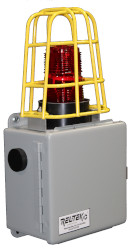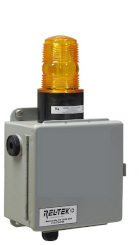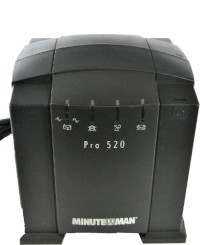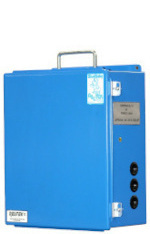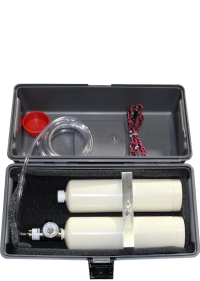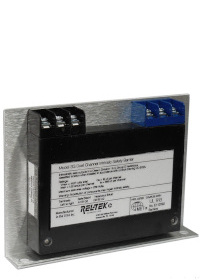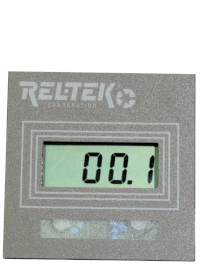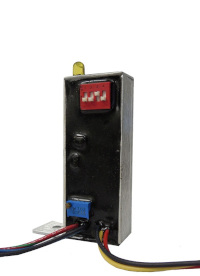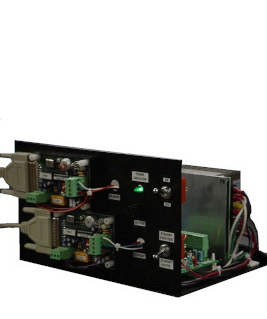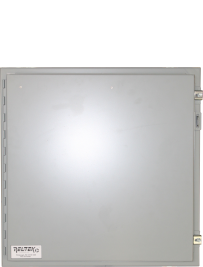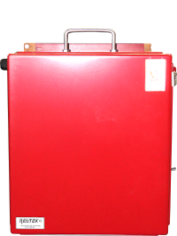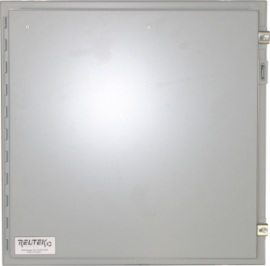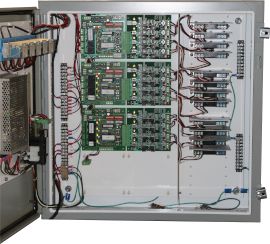The DXcalibar® provides an efficient, economical packaging method to quickly and easily install and manage large arrays of sensors. All essential functions are integrated into a single box, 16 sensors at a time.
To eliminate the 16 sets of cables that would otherwise be required to transfer 16 sensor signals back to a central alarm monitoring point, high speed digital telemetry is included, which multiplexes all signals onto a single twisted pair communication bus. The DX-bus is Rel-Tek's long distance communication mode which has been time tested for reliability and speed in underground mines that extend to 20 miles or more.
The brains in the DXcalibar® reside in the four DX4404 cards, microprocessor based modules which handle the communications and I/O. Each card is capable of monitoring four analog (4-20ma) inputs and four digital contact closure inputs, while controlling four digital (on/off) outputs, all orchestrated through the central computer facility, possibly sited in another building or even miles away. Analog resolution is a high precision 12-bit format, cutting the digitizing error to an infinitesimal .024%.
DXcalibar ® units require communications with a Rel-Tek EZ-Trol/DX computer. Telemetry is via the DX-bus over a single twisted pair of wires at selectable rates -- even as high as 115.2k baud. The proprietary DX-bus and attending protocols have been perfected for long distance and high reliability in noisy environments and includes advance error detection and correction features. The system can be expanded to include as many as 63 DXcalibar® boxes (63x16=1008 sensors).
16 sensor inputs per box is standard, each being a 4-20mA generic analog format. Sixteen dual-channel I.S. barriers are included, one barrier for each sensor. Power is delivered to a sensor through one channel of the barrier and the signal is returned through the second channel. The predominant sensor types used with DXcalibar ® unit are the GasBoss*100 and the GasBoss*100/AP (outdoor and indoor versions), each capable of detecting combustible gases with a range of 0-100% LEL. Both are approved to UL-913, Class I, Div 1 and 2, Group D. Note that Group D includes methane, natural gas, propane, butane, gasoline, diesel fuel, naphtha, alcohol and a host of other flammability fuels. Also, available are the GasBoss* 100-C and the GasBoss* 100/AP-C these newly approved combustible sensors add Group B and C to the mix allowing gas detection in hydrogen locations. They are US and Canadian approved.
16 dual-channel intrinsic safety barriers are included for directly connecting to the sensors sited in hazardous areas. Barriers are also approved to UL-913, Class 1, Div 1 and 2, Group D. It should be noted that I.S. offers lower costs than explosion proof designs, by virtue of the easier installation, easier maintenance and shock proof voltages. Unlike with XP equipment, there is never a need to shut the system down for maintenance. Safety is assured by the low voltage (under 30 VDC) and current, which eliminate ignition sources. X/P equipment loses its safety classification the instant a unit is opened for service. NEC-70 even permits simplified wiring, conduit and seals for I.S. wiring in hazardous areas -- not so for X/P equipment. Along with the new GasBoss* 100-C and GasBoss* 100/AP-C are the newly approved I.S. Barriers for Class 1, Div 1, Groups B, C, D. These UL-913 and CSA C22.2 approved barriers allow gas detection in Groups B, C and D hazardous locations when used approved sensors.
Because I.S. sensors are powered through approved I.S. barriers, sensors can be serviced -- or even replaced -- without disabling the entire monitoring system, and without ever shutting down operations and declassifying the area. Note: DXcalibar ® boxes, including the I.S. barriers, are always installed in fresh air; only the I.S. sensors and I.S. cables may be installed within classified areas.
Another important function is current regulation which assures that each barrier is properly powered and current limited, thus completely eliminating costly and tedious fuse replacement.
On any sensor alarm event, alarms must be sounded and control actions taken to increase ventilation fan speed, to open doors, selectively kill lights and heaters, cut electrical power and the like. In the old octopus days, relay boxes were used for housing the high current control contacts. Now, 16 individually controlled relays are standard in the DXcalibar ®. Relays have gold plated SPDT contacts rated at 24-120 VAC/DC, 5 amp. Also, available are up to six additional high current relays contacts rated at 24-120V AC/DC., 10 amps. These relay are available as DPDT or 3PDT versions.
Sensors are seldom sited with easy access. Methane and natural gas sensors are normally installed in the roof peaks and skylight areas, because methane is lighter than air. Propane, sensors, are placed low, near the floor and in service pits, because this gas is heavier than air. Automatic calibration permits each sensor to be calibrated and adjusted without risking accidents with lifts and ladders. There is also no need to stop production and move vehicles out of the way to access sensors directly. On installation, plastic gas supply tubing is installed for delivering calibration gas to each sensor from a convenient floor level station. The four 4-channel Current Limiter Card circuit boards in the DXcalibar ® box permits each sensor signal (4-20ma) to be finely adjusted. Test jacks are included on these Current Limiter Cards for reading out the raw signal from each sensor as well as the calibrated signal, using a hand held milli-ammeter.
An innovative computer calibration utility in the Millennia-DX and FT versions of the monitoring software provides additional speed and simplicity for automating the once tedious sensor calibration.
Sixteen digital inputs (dry contact closures) are included within the DXcalibar ® for connecting switches and any other contact switching devices. The DXcalibar ® is designed to house switches on the front lid, thus avoiding yet another wall mount box. Note that by using I.S. barriers for electrical access, such simple, non-incendive switches may be sited in hazardous areas.
Power supply and backup battery -- Yet another box to be eliminated by DXcalibar ® is the power supply and battery backup. The DXcalibar ® is powered from 24-28 VDC, drawing typically 4 amps per box, fully loaded. A power supply can be mounted inside the enclosure. There is also space for two 12V, 4 AH rechargeable batteries, powering the DXcalibar ®, with normal sensor and alarm loads during a brownout or power outage.
A distinctive, raucous horn and a brilliant strobe can be mounted directly on the DXcalibar ®, thus eliminating more octopus components. If desired, additional alarms can still be sited remotely from the box, powered and controlled in unison - or individually, as programmed through the computer.
Each four channel, side-to- side strip of components is independent. A complement of one to four strips can be included to meet the sensor count at the particular site. Because strips are identical, just one set of components (DX4404, Current Limiter Card and barrier) provides spares for all strips, including those in other DXcalibar ® units throughout the facility.
LEDs show the power and communication status of each module and sensor. A malfunction is immediately indicated, making troubleshooting fast and sure.
Barriers are short circuit protected, such that an external wiring short on a sensor circuit will not damage the attending barrier. Unlike with competitor's barriers that are frequently damaged on a short circuit, the high speed current limiters avoid this problem -- and, there is never a fuses to replace.
For ease of maintenance, the DX4404 and Current Limiter modules plug together. Replacing any of the eight modules (4 of each type) is reduced to simply pulling the plugs, lifting the module off stand-offs, inserting a replacement module and replacing the plugs -- all without any tools.
There is plenty of access space inside the DXcalibar ®. Holes are provided for adding extra I/O cards and utility modules, as may be needed for extra fresh-air monitoring, custom control functions or to add a communications repeater and optical isolator. Our designers thought of everything!
The DXcalibar ® is UL 508 Approved. DXcalibar ® is covered by Rel-Tek's US Patent 6,109,488.
Rel-Tek has engineered the DXcalibar ® -- including all circuit boards, barriers and computer software -- in house, and offers full warranty and service without the delay and expense of third party suppliers. Contact the factory for assistance in laying out a system for your particular application.
